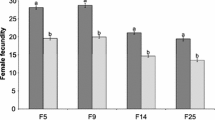Abstract
Urolepis rufipes Ashmead, a recently discovered parasitoid of house flies at New York dairies, was reared at 15, 20, 25, 30 and 34°C to measure daily fertility, fecundity and adult survivorship. Little reproduction occurred at 15°C, and only a few ♀ successfully emerged at 34°C. The intrinsic rate of growth was fastest at 30°C (0.282 ♀/day), but fecundity was highest at 25°C (165.5 hosts attacked, producing 124.5 progeny). Some reproductive statistics at 25°C were: net reproductive rate (R0=72.1 ♀/♀, generation time =18.7 days, intrinsic rate of increase (rm)=0.228, finite rate of increase (λ)=1.26, daily birth rate =0.302, daily death rate =0.021 and Fisher's reproductive value =418. Sex ratio (average =75.9%) did not vary significantly with temperature (between 20–30°C) nor with mother's age.
Résumé
L'Urolepis rufipes Ashmead, parasitoïde de la mouche,Musca domestica L, récemment découvert dans les fermes laitières de l'état de New York, aux Etats-Unis, a été élevé à des températures de 15, 20, 25, 30 et 34°C afin de mesurer quotidiennement le taux de fertilité, de fécondité et de survie chez les adultes. On a observé peu d'activité reproductrice ou de développement à 15°C et seules quelques femelles sont arrivées à éclore à 34°C. Le taux de croissance intrinsèque était le plus rapide à 30°C (0,282), mais le taux de fécondité était le plus élevé à 25°C (165,5 hôtes attaqués, produisant une descendance de 124,5). A 25°C le taux net de reproduction (R0)=72,1 femelles/femelle, temps de survie =18,7 jours, taux de croissance intrinsèque (rm)-0,228, taux d'augmentation fini (λ)=1,256, taux quotidien de natalité =0,302, taux quotidien de mortalité =0,021, valeur reproductive de Fischer =417,7. La proportion des sexes (en moyenne 75,9%) n'a varié d'une manière significative ni avec la température (entre 20–30°C), ni avec l'âge de la mère.
Similar content being viewed by others
References
Axtell, R. C &Rutz, D. A. — 1986. Role of parasites and predators as biological fly control agents in poulty production facilities. —Misc. Publ. Entomol. Soc. Am. 61, 88–100.
Ables, J. R. &Shepard, M. — 1974. Responses and competition of the parasitoidsSpalangia endius andMuscidifurax raptor [Hymenoptera: Pteromalidae] at different densities of house fly pupae. —Can. Entomol. 106, 825–830.
Andrewartha, H. G. &Birch, L. C. — 1954. The Distribution and Abundance of Animals. —University of Chicago Press, Chicago.
Birch, L. C. — 1948. The intrinsic rate of natural increase of an insect population. —J. Anim. Ecol., 17, 15–26.
Coats, S. A. — 1976. Life cycle and behavior ofMuscidifurax zaraptor [Hymenoptera: Pteromalidae] —Ann. Entomol. Soc. Am., 69, 772–780.
Conover, W. J. — 1980. Practical nonparametric statistics, 2nd edn. —John Wiley & Sons, N. Y.
Filipponi, A. &Petrelli, M. G. — 1966. L'innata capacita di incremento numerico diMusca domestica L. —Riv. Parassitol., 27, 235–260. [Ital.:Engl.].
Fisher, R. A. — 1930. The genetical theory of natural selection. —Claredon Press, Oxford.
Force, D. C. — 1970. Competition among four hymenopterous parasites of an endemic insect host. —Ann. Entomol. Soc. Am., 63, 1675–1688.
Hassell, M. P. — 1978. The dynamics of arthropod predator-prey systems. — Monogr. Popul. Biol. vol. 13,Princeton Univ. Press, Princeton, N. J.
Huffaker, C. B. &Messenger P. S. (eds.) — 1976. Theory and Practice of Biological Control. —Academic Press, New York.
Legner, E. F. — 1967. Behavior changes the reproduction ofSpalangia cameroni, S. endius, Muscidifurax raptor, andNasonia vitripennis [Hymenoptera: Pteromalidae] at increasing fly host densities. —Ann. Entomol. Soc. Am., 60, 819–826.
Legner, E. F. — 1969. Adult emergence interval and reproduction in parasite hymenoptera influenced by host size and density. —Ann. Entomol. Soc. Am., 62, 220–226.
Messenger, P. S. — 1964. Use of life tables in a bioclimatic study of an experimental aphid-braconid wasp host-parasite system. —Ecology, 45, 119–131.
Morgan, P. B. — 1981. The potential use of parasites to controlMusca domostica L. and other filth breeding flies at agricultural installations in the southern United States. In: Proc. Workshop on Status of Biological Control of Filth Flies,USDA, SEA, Gainesville, FL. February 4–5, 1981.
Morgan, P. B., Weidhaas, D. E. &Patterson, R. S. — 1981. Programmed releases ofSpalangia endius andMuscidifurax raptor against estimated populations ofMusca domestica [Diptera: Muscidae] —J. Med. Entomol., 18, 158–166.
Nagel, W. P. &Pimentel, D. P. — 1963. Some ecological attributes of a pteromalid parasite and its house fly host. —Can. Entomol., 95, 208–213.
Nagel, W. P. &Pimentel, D. P. — 1964. The intrinsic rate of natural increase of the pteromalid parasiteNasonia vitripennis (Walk.) on its muscoid hostMusca domestica L. —Ecology, 45, 658–660.
Petersen, J. J., Guzman, D. R. &Pawson, B. M. — 1985.Urolepis rufipes [Hymenoptera: Pteromalidae], a new parasite record for filth flies [Diptera: Muscidae] in Nebraska, USA. —J. Med. Entomol., 22, 345.
Rabinovich, J. E. — 1968. Contribución al estudio de la dinámica de poblaciones. I. Análisis poblacional deNasonia vitripennis Walk. [Hymenoptera: Pteromalidae]. —Acta Biol. Venez., 61, 68–81. [Span.:engl.].
Rutz, D. A. &Axtell, R. C. — 1980. Invasion and establishment of house fly,Musca domestica [Diptera: Muscidae], parasites [Hymenoptera: Pteromalidae] in new caged-layer poultry houses. —J. Med. Entomol., 17, 151–155.
Smith, L. &Rutz, D. A. — 1985. The occurrence and biology ofUrolepis rufipes [Hymenoptera: Pteromalidae], A parasitoid of house flies in New York dairies. —Environ. Entomol., 14, 365–369.
Smith, L. &Rutz, D. A. — 1986. Development rate and survivorship of immatureUrolepis rufipes [Hymenoptera: Pteromalidae], a parasitoid of pupal house flies. —Environ. Entomol., 15, 1301–1306.
Snedecor, G. W. &Cochran, W. G. — 1980. Statistical methods, 7th edn. —Iowa State Univ. Press, Ames, Iowa.
Taylor, F. — 1979. Convergence to the stable age distribution in populations of insects. —Am. Nat., 113, 511–530.
Weidhaas, D. E., Haile, D. G., Morgan, P. B. &LaBreque, G. C. — 1977. A model to simulate control of house flies with a pupal parasite,Spalangia endius —Environ. Entomol., 6, 489–500.
Author information
Authors and Affiliations
Rights and permissions
About this article
Cite this article
Smith, L., Rutz, D.A. Reproduction, adult survival and intrinsic rate of growth ofUrolepis rufipes [Hymenoptera: Pteromalidae], a pupal parasitoid of house flies,Musca domestica . Entomophaga 32, 315–327 (1987). https://doi.org/10.1007/BF02372440
Received:
Accepted:
Issue Date:
DOI: https://doi.org/10.1007/BF02372440




